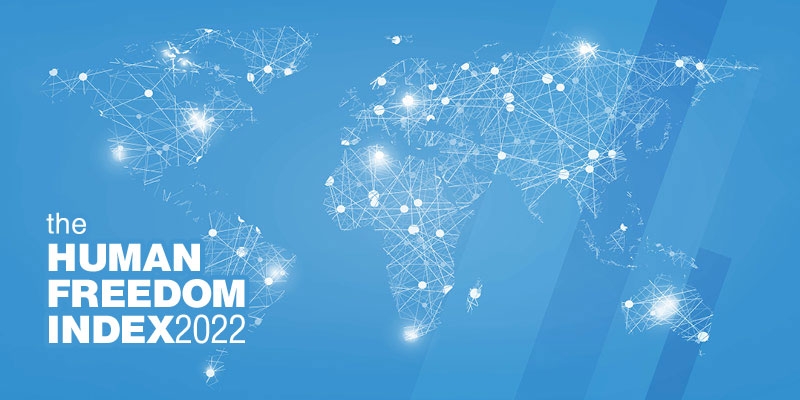Human Freedom Index 2022

The Human Freedom Index (HFI) presents a broad measure of human freedom, understood as the absence of coercive constraint. This eighth annual index uses 83 distinct indicators of personal and economic freedom in the following areas:
- Rule of law
- Security and safety
- Movement
- Religion
- Association, assembly, and civil society
- Expression and information
- Relationships
- Size of government
- Legal system and property rights
- Sound money
- Freedom to trade internationally
- Regulation
The HFI is the most comprehensive freedom index so far created for a globally meaningful set of countries and jurisdictions representing 98.1 percent of the world’s population. The HFI covers 165 jurisdictions for 2020, the most recent year for which sufficient data are available. The index ranks jurisdictions over a span of two decades, beginning in 2000, the earliest year for which a robust enough index could be produced.
Human freedom deteriorated severely in the wake of the coronavirus pandemic. Most areas of freedom fell, including significant declines in the rule of law; freedom of movement, expression, association and assembly; and freedom to trade. On a scale of 0 to 10, where 10 represents more freedom, the average human freedom rating for 165 jurisdictions fell from 7.03 in 2019 to 6.81 in 2020. On the basis of that coverage, 94.3 percent of the world’s population saw a fall in human freedom from 2019 to 2020, with many more jurisdictions decreasing (148) than increasing (16) their ratings and 1 remaining unchanged. The sharp decline in freedom in 2020 comes after years of slow descent following a high point in 2007 and sets global freedom to a level far below what it was in 2000, previously the lowest point in the past two decades.
The data show that there is an unequal distribution of freedom in the world, with only 13.4 percent of the world’s population living in the top quartile of jurisdictions in the HFI and 39.9 percent living in the bottom quartile.
The countries that took the top 10 places, in order, were Switzerland, New Zealand, Estonia, Denmark, Ireland, Sweden, Iceland, Finland, Netherlands, and Luxembourg. Selected jurisdictions rank as follows: Canada (13), Taiwan (14), Japan (16), Germany (18), United Kingdom (20), United States (23), South Korea (30), Chile (32), France (42), Argentina (74), South Africa (77), Brazil (80), Ukraine (89), Mexico (98), India (112), Russia (119), Nigeria (124), Turkey (130), China (152), Saudi Arabia (159), Iran (162), Venezuela (163), and Syria (165). Out of 10 regions, those with the highest levels of freedom are Western Europe, North America (Canada and the United States), and Oceania. The lowest levels are in the Middle East and North Africa, sub-Saharan Africa, and South Asia. Women-specific freedoms, as measured by five indicators in the index, are strongest in North America, Western Europe, and East Asia and are least protected in the Middle East and North Africa, South Asia, and sub-Saharan Africa.
Jurisdictions in the top quartile of freedom enjoy a significantly higher average per capita income ($48,644) than those in other quartiles; the average per capita income in the least free quartile is $11,566. The HFI also finds a strong relationship between human freedom and democracy.
The findings in the HFI suggest that freedom plays an important role in human well-being, and they offer opportunities for further research into the complex ways in which freedom influences, and can be influenced by, political regimes, economic development, and the whole range of indicators of human well-being.
Authors:
More from this study
Subscribe to the Fraser Institute
Get the latest news from the Fraser Institute on the latest research studies, news and events.




